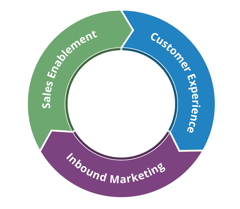Have you heard of the flywheel? The flywheel is the next iteration of the funnel and consists of acquiring customers, engaging customers, and delighting customers to restart the cycle. Like all wheels, friction exists at every contact point that can hinder the flywheel from spinning efficiently, and there are process optimizations that need to happen to reduce that friction. These potential issues include poor tools, people in the wrong roles, and information asymmetry. All this friction hinders your growth, which is where the concept of Revenue Operations (RevOps) comes in.
Revenue Operations combines and aligns revenue goals throughout a business's marketing, sales, and success teams, so they are completely connected and no longer working independently. You should not put sales, marketing, and customer success operations in different business areas. For true success, those three areas must be together under one roof. Your central RevOps organization ensures:
-
the data flow throughout the organization
-
the tech stack speaks with one voice
-
the efforts of one part of the organization don’t interfere with the success of another
Why Is RevOps Important?
The role of Revenue Operations is to ensure accountability among the teams within your organization that are responsible for driving revenue. The teams responsible for this are sales, marketing, and customer service. Did you know consistent revenue growth is challenging for 78% of B2B companies across all industries? A well-executed and thoughtful Revenue Operations strategy may solve the challenges that could be hindering your revenue growth.
How Does RevOps Impact Sales & Marketing?
When sales and marketing organizations are aligned instead of working in silos, there is a synergy between organizational workflows and processes that outline a clear path for leads and customers to move between different departments and individuals internally. This alignment process reduces friction in the flywheel. Aligning your sales and marketing teams occurs when there is consistent team communication, along with the guidance and direction of your sales enablement and marketing ops leaders.
According to the SiriusDecisions State of RevOps Study, the most significant areas of misalignment for B2B companies are between the sales enablement and customer service and the marketing ops and customer service organizations. This misalignment internally displays an apparent disconnect between how companies need to operate to keep their customers happy and how companies are currently functioning. RevOps brings these groups together, providing effective cross-functional support for your customers.
How Can You Start to Adopt a Revenue Operations Strategy?
Many companies are in the process of adopting a Revenue Operations strategy. According to HubSpot, between 2018 and 2019, there was an 80% increase in companies building a Revenue Operations group. But how can you get started?
-
Determine Who Will Fill This RevOps Role Internally: Many companies have started to adopt the role of Chief Revenue Officer. This individual is responsible for sales, marketing, and customer service and leads the strategy, implementation, and ongoing support for these three departments so they are all under one primary group instead of working in silos.
-
Evaluate Your Tech Stack: Technology is the backbone of organizations. Suppose your company uses one tool for your sales CRM, another for marketing automation, and another for customer service. In that case, your data is likely disconnected, and you are not working as efficiently as possible. Consider bringing in a third party to do a full tech stack audit to get an unbiased opinion of your current tools, recommendations on where you could be in the future with your toolset, and ultimately a path forward.
-
Map Your New Process Workflows: After you adopt new technology or realize your tools could be working more efficiently than you already have (which could be a time-intensive process), it's time to map your new process workflows. Work with sales, marketing, and customer service to determine when leads should move from sales to marketing, which customer service tickets go to customer service, which sales questions may return to sales, etc. Knowing who owns every type of customer and prospect interaction is critical so you reduce friction and put your customer at the center of the process.
-
Continue to Optimize Your Process: This process of RevOps is not going to be a one-time initiative. It will be an ongoing process to make sure you are always accounting for what is working and what is not working to make your internal and external-facing communication as seamless as possible.
A lot goes into RevOps when considering its impact across marketing, sales, and customer service. But this is essential to ensuring your organization is aligned and that your prospects and customers are getting the best service possible to keep them as happy customers who are continually part of your customer flywheel.
If you're interested in learning how you can adopt a RevOps mindset, I invite you to schedule a strategy session with a member of our team. We would be happy to discuss your current internal structure and any changes you may want to implement to move forward to a more integrated Revenue Operations strategy.


__Square.png?width=250&height=250&name=Marketing_Hub_(1)__Square.png)




.png?width=250&name=diamond-badge-color%20(1).png)
